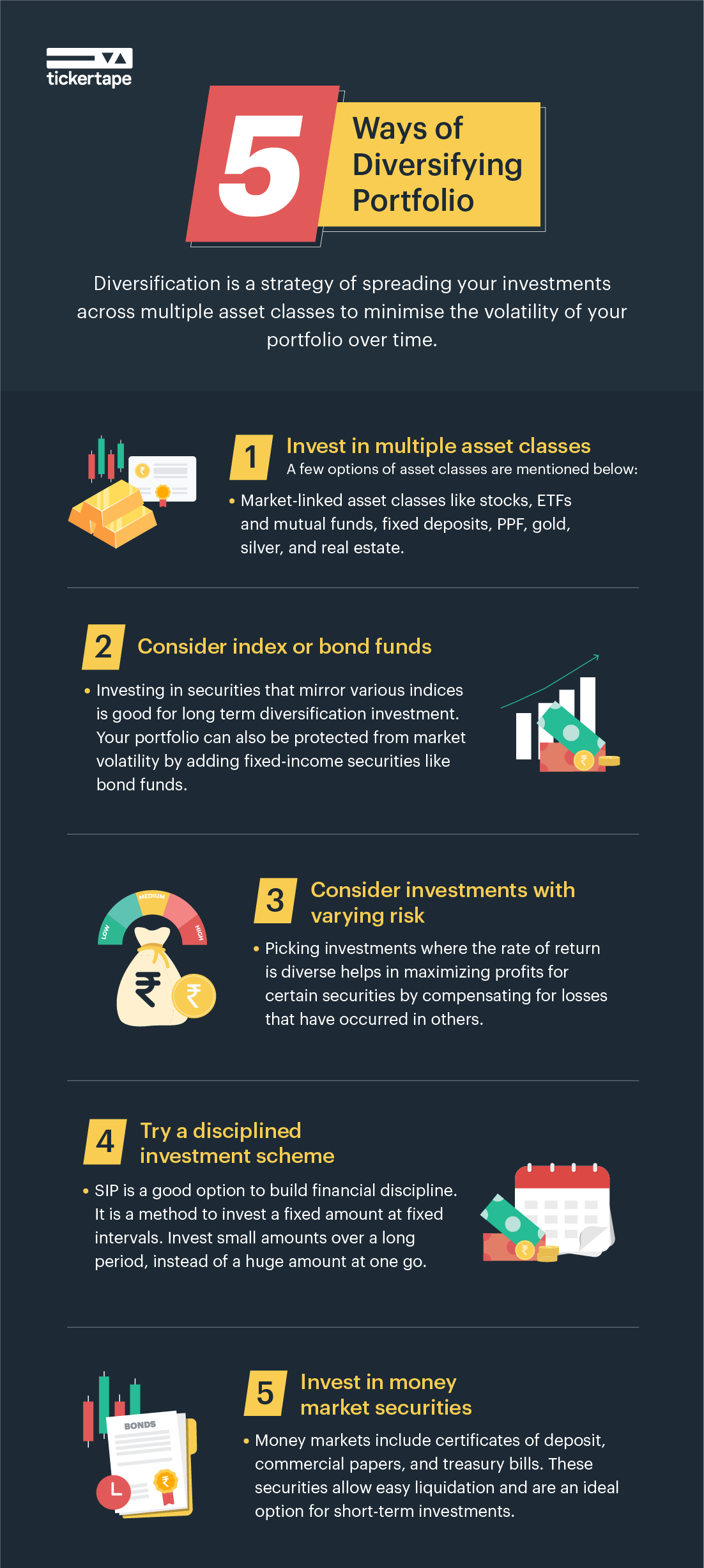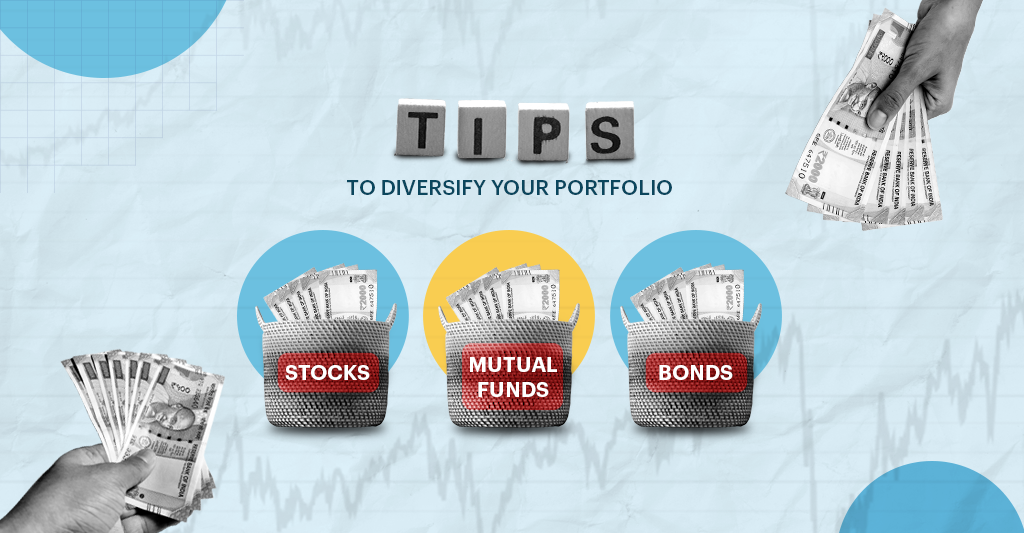Last Updated on May 24, 2022 by Anjali Chourasiya
Different nutrients in adequate amounts are essential for maintaining a healthy body. Similarly, rather than investing heavily in one asset class, having a variety in your investment portfolio is necessary for maintaining its health. This is where risk diversification comes into play. Simply put, a diversified portfolio consists of different asset classes where each asset class has unique risk and return profile. Let’s look into it while wearing our investor’s cap.
Table of Contents
Why is portfolio diversification important?
Suppose you only have fixed deposits and Public Provident Fund (PPF) in your portfolio, and the equity market rises; you will lose out on the potential returns. Or, look at the picture from the opposite angle: you only have equity-oriented investments in your portfolio and the stock market nosedives. Your portfolio will decline and you will lose your savings.
That is why it is better to have a healthy mix of different assets to benefit from the exposure to different investment avenues. This is called risk diversification and it is beneficial because:
- It maximises the return potential.
- You can diversify risk and get stability in your portfolio.
- Diversification of risk helps in tax planning.
How to diversify your portfolio?
Now that you know the importance of risk diversification, let us discuss some methods on how to diversify. Portfolio diversification is not rocket science. You need to understand some basic aspects of investment to build a diversified portfolio. Here are some tips on how you can start:
Opt for different types of asset classes
There are several investment avenues in the market. To diversify risk in your portfolio, you can invest in different types of assets. If you are wondering how to diversify, here are some assets that you can consider:
- You can invest in the market-linked asset class including stocks, mutual funds, and ETFs.
- You can invest in fixed deposits, PPF, National Savings Certificates(NSC), Sukanya Samriddhi Yojana, and the likes for guaranteed returns.
- You can also invest in precious metals such as gold or silver.
- You can also invest in real estate either with your funds or by availing a home loan.
Moreover, when investing in market-linked avenues like stocks or mutual funds, try and opt for different schemes. Diversification is essential even when you choose stocks. Try to invest in stocks of different companies in different sectors to spread the risk across numerous areas. In mutual funds, choose from various schemes based on your investment preference and risk appetite.
Understand the features and benefits of every avenue and then invest in those avenues. Also, it is better to list down your financial goals while investing as it is vital to creating a budget. When you have a clear picture of what you want, it can help you achieve your financial goals. You can do this by deciding what part of your income you want to save, spend and invest. After that, think of the kind of diverse portfolio you want to create keeping in mind your risk appetite.
Maintain a healthy combination of equity and debt
Equity is risky but has a great return generating potential. Debt, on the other hand, has low risk but offers moderate returns. To get the best results, a mix of equity and debt is better. However, keep your risk tolerance in mind. If you have a higher risk tolerance, you can allocate a primary portion of your portfolio, say 70-80%, to equity and the remaining 20-30 % to debt. On the other hand, if you have a lower risk tolerance, you can consider investing 50% to 60% in debt and the remaining amount in equity.
Equity funds are risky. But the risk is easily mitigated with time, and you can earn attractive returns. So, irrespective of your risk appetite, consider maintaining both equity and debt in your portfolio for good returns and stability.

Practice rebalancing
Rebalancing means maintaining and making necessary changes to your asset allocation. It helps you to maintain the ratio between equity and debt in your portfolio at the desired level. Since the market is dynamic, your portfolio will grow as you earn returns. This growth may change the ratio between equity and debt in your portfolio. In that case, rebalancing can help restore the ratio.
For example, say the equity to debt allocation in your portfolio is 60:40. The stock market rises, and your equity investments grow considerably, changing the ratio to 70:30. To maintain the 60:40 ratio, you need to rebalance your portfolio by reducing your equity allocations and increasing the debt allocations.
You can also try and modify the ratio based on market trends to earn higher returns. Rebalancing, therefore, allows you to monitor your portfolio and maintain its diversification.
Do not forget tax planning
While selecting investment avenues, it is better to keep the tax angle in mind. There are various tax-saving investment options available in India. Common examples include Equity-linked Savings Schemes(ELSS), Public Provident Fund(PPF), National Savings Certificates(NSC), Sukanya Samriddhi Yojana(SSY) and 5-yr fixed deposits. So, to diversify risk, picking assets that give you tax benefits can help save taxes.
Conclusion
Successful investing is an art, and diversification of risk is one of its aspects. So, playing favourites might not prove healthy when it comes to investments. Instead, consider portfolio diversification by choosing different types of assets.
You can use the tips mentioned above for diversification of risk and earn higher profits. You can also use Tickertape’s investment tools to evaluate and pick the right avenues for a diversified portfolio. As it offers you stock analysis tools, investment guides, research solutions and many more tools which can help you plan your investments right.
You can do research on your part by yourself or through Tickertape’s offered tools, then based on your needs you can opt for diversification.
- Top Large Cap Funds 2025: Discover Blue Chip Performers - Mar 27, 2025
- Gilt Funds in India: Features, Meaning, and Advantages - Mar 13, 2025
- Best Index Funds in India 2025: Top Performing Mutual Funds - Mar 13, 2025




